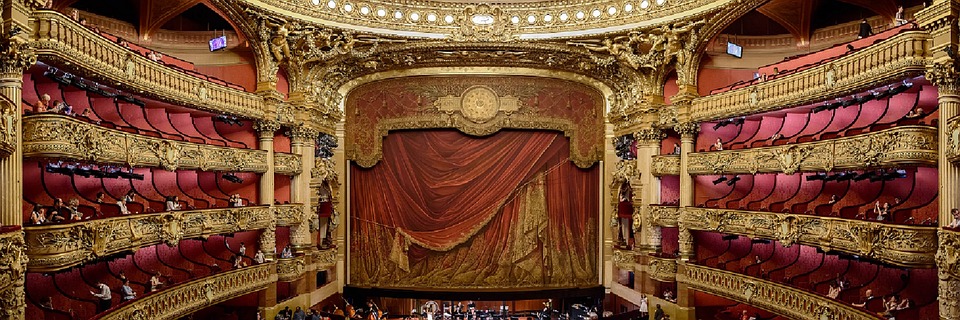A Trip to Paris: Visiting the French Capital’s Most Famous Attractions (Part 11) Posted by mtaulier on Dec 20, 2013 in Culture, Music, Uncategorized
In the last post we learned about the Musée d’Orsay and its rich collection of western art. Today we will cross the Seine River to visit the Palais Garnier (Garnier Palace), home of the Opéra de Paris (Paris Opera) opera company. The Palais Garnier is often referred to simply as the Opéra de Paris, however since 1989 it has had to share that distinction with another, more modern opera house called l’Opéra Bastille (Bastille Opera House) located at the Place de la Bastille (Bastille Plaza), site of the old prison that ignited the French Revolution in 1789.

The Palais Garnier is probably best known as the setting for the novel Le Fantôme de l’Opéra (The Phantom of the Opera) written by Gaston Leroux in 1910. Andrew Lloyd Webber brought the story to life in the 1986 musical of the same name which has not ceased to captivate audiences autour du monde (around the world). You might recall from an earlier post that Notre-Dame cathedral was the setting for Victor Hugo’s 1831 novel Notre-Dame de Paris (also known as The Hunchback of Notre-Dame), which has also garnered worldwide acclaim and has been adapted to the stage as well as to film. It is clear that Paris has the ability to inspire les écrivains et les artistes (writers and artists) in a way that few cities can.
Construction of the Palais Garnier began during the Second Empire sous le règne de Napoleon III (under the reign of Napoleon III). Like the building of le Sacré-Cœur de Montmartre, l’Arche de la Défense and le Musée d’Orsay, a contest was held to select an architect who could take on the formidable task of building a new opera house for the city of Paris. In June of 1861, Charles Garnier, un jeune architecte avec très peu d’expérience (a young architect with very little experience), was chosen from among a stable of famed architects including Eugène Emmanuel Viollet-le-Duc. Work on the opera house commenced in August of that same year. The outbreak of the Franco-Prussian War in 1870 brought construction to a temporary halt but building resumed shortly thereafter. On January 5, 1875 president de la République Marshal Mac-Mahon inaugurated the newly completed theater and word quickly spread throughout the European continent and abroad of Garnier’s achievement. The new Opéra de Paris drew praise for its Italian styling and eclecticism courtesy of a bevy of talented artists and sculptors from all over France. The edifice also housed the world’s largest stage in an auditorium that could seat up to 2,156 people.
The interior of the opera house is nothing short of breath-taking. Le Grand Foyer (the Great Foyer), for example, rivals Versaille’s Gallerie des Glaces (Hall of Mirrors) in its opulence and ornate styling. Garnier used enamel mosaics to create the beautiful voûtes dorées (gilded vaults) and hired French painter Paul Baudry to paint the ceiling. It took Baudry no less than ten years to finish the project. People are usually familiar with Michelangelo’s masterful work on the ceiling of the Sistine Chapel but few are aware of Baudry’s work which, in my mind, is no less impressive. Les Rotondes (the Rotundas), reserved for the Parisian elite, and le Grand Escalier (the Grand Staircase) made of white marble complement the interior but la Salle de Spectacle (the Auditorium) is where the magic happens. If you have a chance to attend an opera, ballet or concert/recital at the Palais Garnier, don’t miss it.
If all you want to do is visit the Palais Garnier, tickets are 10€ which gives you free access to most areas. Hours are from 10 am to 5 pm every day. If you wish to purchase tickets to attend an opera, ballet or concert/recital, the Opéra de Paris website has a calendar with upcoming events you can separate by genre. You can reserve your seats directly on the website. Don’t forget that the Opéra Bastille offers a wide array of spectacles in a thoroughly modern setting so don’t limit yourself to just the Palais Garnier.
Join us next week as we embark on la dernière étape (the last leg) of our journey through Paris by visiting le Cimetière du Père-Lachaise (the Père-Lachaise Cemetery).

Build vocabulary, practice pronunciation, and more with Transparent Language Online. Available anytime, anywhere, on any device.



